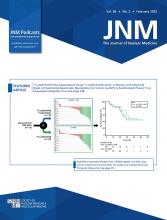Visual Abstract
Abstract
High-sensitivity total-body PET enables faster scans, lower doses, and dynamic multiorgan imaging. However, the higher system cost of a scanner with a long axial field of view (AFOV) hinders its wider application. This paper investigates the impact on the lesion quantification and detectability of cost-effective total-body PET sparse designs. Methods: Using the PennPET Explorer (PPEx) as a model, 3 sparse configurations with the same 142-cm AFOV were considered, including designs with only axial gaps (AGs), only transverse gaps (TGs), and a mixture of AGs and TGs (MG), with retained detector fractions (DFs) ranging from 71% to 40%. Human data from the PPEx were used to emulate sparse designs by discarding lines of response as a proxy for missing detectors. We embedded lesion events in the resultant list data with varying uptakes in the lung and liver before reconstruction. A generalized scan statistics methodology was used to measure lesion detectability and quantification as a function of lesion uptake and scan duration. Results: Relative to a fully populated system, an AG design with 71% performs well but is susceptible to image artifacts as the DF decreases to 58%. A TG design performs well with a DF of 58% but requires twice the scan time to achieve similar lesion detectability and is susceptible to transverse field-of-view truncation below 60 cm as the DF is further decreased. An MG design with a DF of 58% requires 3 times the scan time to achieve similar lesion detectability, and with no evidence of artifacts even as the DF is decreased to 40%. Conclusion: Sparse designs with artifact-free images can provide comparable lesion quantification and detectability to the fully populated PPEx after compensating for the reduced sensitivity with increased scan time. Because an AG design is more susceptible to image artifacts with a lower DF, a system with only AGs is not an optimal choice for dramatic cost reduction. A TG design provides a higher relative sensitivity than AG or MG designs for a given DF, leading to a shorter scan time to achieve comparable lesion detectability. However, the increased truncation of the transverse field of view with decreasing DF limits this design choice. An MG design allows for the greatest cost reduction (lowest DF) if the scan duration is increased to compensate for the higher loss in sensitivity. Sparse designs of PET with a long AFOV provide a technologic solution for introducing such systems at reduced cost into routine clinical use.
Footnotes
Published online Jan. 16, 2025.
- © 2025 by the Society of Nuclear Medicine and Molecular Imaging.
This article requires a subscription to view the full text. If you have a subscription you may use the login form below to view the article. Access to this article can also be purchased.
SNMMI members
Login to the site using your SNMMI member credentials
Individuals
Login as an individual user








